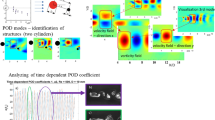Abstract
In this paper, the velocity-based POD and the vorticity-based POD have been systematically compared in three characteristic regions of the flow downstream of a two-dimensional circular cylinder, namely the near, intermediate and far wakes. The two-point space correlation function is used to determine which of the two methods is better suited for extracting the large-scale flow structures based on the repartition of energy among the different POD modes. It is found that the POD, based on the lateral velocity fluctuation v, leads to the most optimum extraction in all three flow regions, while the vorticity-based POD is only effective in the near and intermediate wakes. Based on two-point space correlation functions, a scenario is proposed for the application of POD to the present two-dimensional wake .















Similar content being viewed by others
References
Antonia RA, Browne LWB (1987) Average wavelength of organized structures in the turbulent far wake of a cylinder. Exp Fluids 5:298–304
Antonia RA, Browne LWB, Bisset DK, Fulachier L (1987) A description of the organized motion in the turbulent far wake of a cylinder at low Reynolds number. J Fluid Mech 184:423–444
Bisset DK, Antonia RA, Browne LWB (1990) Spatial organization of large structures in the turbulent far wake of a cylinder. J Fluid Mech 218:439–461
Browne L, Antonia R, Shah D (1989) On the origin of the organised motion in the turbulent far-wake of a cylinder. Exp Fluids 7:475–480
Dipankar A, Sengupta TK, Talla SB (2007) Suppression of vortex shedding behind a circular cylinder by another control cylinder at low Reynolds numbers. J Fluid Mech 573:171–190
Duggleby A, Ball KS, Paul MR, Fischer PF (2007) Dynamical eigenfunction decomposition of turbulent pipe flow. J Turbul 8:1–24
Feng L, Wang J, Pan C (2011) Proper orthogonal decomposition analysis of vortex dynamics of a circular cylinder under synthetic jet control. Phys Fluids 23:014106
Fogleman M, Lumley J, Rempfer D, Haworth D (2004) Application of the proper orthogonal decomposition to datasets of internal combustion engine flows. J Turbul 5:N23
Gordeyev S, Thomas F (2000) Coherent structure in the turbulent planar jet. Part 1: extraction of proper orthogonal decomposition eigenmodes and their self-similarity. J Fluid Mech 414:145–194
Gurka R, Liberzon A, Hetsroni G (2006) POD of vorticity fields: a method for spatial characterization of coherent structures. Int J Heat Fluid Flow 27:416–423
Hayakawa M, Hussain F (1989) Three-dimensionality of organized structures in a plane turbulent wake. J Fluid Mech 206:375–404
Johansson PBV, George WK, Woodward SH (2002) Proper orthogonal decomposition of an axisymmetric turbulent wake behind a disk. Phys Fluids 14:2508–2514
Joshi J, Tabib M, Deshpande S, Mathpati C (2009) Dynamics of flow structures and transport phenomena, 1. Experimental and numerical techniques for identification and energy content of flow structures. Ind Eng Chem Res 48:8244–8284
Kellnerova R, Kukacka L, Jurcakova K, Uruba V, Janour Z (2012) PIV measurement of turbulent flow within a street canyon: detection of coherent motion. J Wind Eng Ind Aerodyn 63:302–313
Kim YH, Cierpka C, Werely S (2011) Flow field around a vibrating cantilerver: coherent structure eduction by continuous wavelet transform and proper orthogonal decomposition. J Fluid Mech 669:584–606
Konstantinidis E, Balabani S, Yianneskis M (2007) Bimodal vortex shedding in a perturbed cylinder wake. Phys Fluids 19(011):701
Kostas J, Soria J, Chong M (2002) Particle image velocimetry measurements of a backward-facing step flow. Exp Fluids 33:838–853
Kostas J, Soria J, Chong MS (2005) A comparison between snapshot POD analysis of PIV velocity and vorticity data. Exp Fluids 38:146–160
Lefeuvre N, Djenid L, Antonia RA, Zhou T (2014) Turbulent kinetic energy and temperature variance budgets in the far-wake generated by a circular cylinder. In: 19th Australasian fluid mechanics conference
Liberzon A, Gurka R, Tiselj I, Hetsroni G (2005) Spatial characterization of the numerically simulated vorticity fields of a flow in a flume. Theor Comput Fluid Dyn 19:115–125
Lumley JL (1967) The structure of inhomogeneous turbulent flows. In: Yaglam AM, Tatarsky VI (eds) Proceedings of the international colloquium on the fine scale structure of the atmosphere and its influence on radio wave propagation. Nauka, Moscow, pp 166–178
Ma X, Karamanos GS, Karniadakis GE (2000) Dynamics and low dimensionality of a turbulent near wake. J Fluid Mech 410:29–65
Meyer KE, Pedersen JM, Ozcan O (2007) A turbulent jet in crossflow analysed with proper orthogonal decomposition. J Fluid Mech 583:199–227
Murray N, Sallstrom E, Ukeiley L (2009) Properties of subsonic open cavity flow flelds. Phys Fluids 21(095103)
Sirovich L (1987) Turbulence and the dynamics of coherent structures. Part I: coherent structures. Q Appl Math 45:561–571
Tabib MV, Joshi JB (2008) Analysis of dominant flow structures and their flow dynamics in chemical process equipment using snapshot proper orthogonal decomposition technique, chemical engineering science. Chem Eng Sci 63:3695–3715
Townsend AA (1956) The structure of turbulent shear flow, 1st edn. Cambridge University Press, Cambridge
Zhou Y, Antonia RA (1992) Convection velocity measurements in a cylinder wake. Exp Fluids 13:63–70
Zhou Y, Zhang HJ, Yiu MW (2002) The turbulent wake of two side-by-side circular cylinders. J Fluid Mech 458:303–332
Acknowledgments
The Australian Research Council (ARC) is gratefully acknowledged for its financial support.
Author information
Authors and Affiliations
Corresponding author
Rights and permissions
About this article
Cite this article
Tang, S.L., Djenidi, L., Antonia, R.A. et al. Comparison between velocity- and vorticity-based POD methods in a turbulent wake. Exp Fluids 56, 169 (2015). https://doi.org/10.1007/s00348-015-2038-z
Received:
Revised:
Accepted:
Published:
DOI: https://doi.org/10.1007/s00348-015-2038-z




